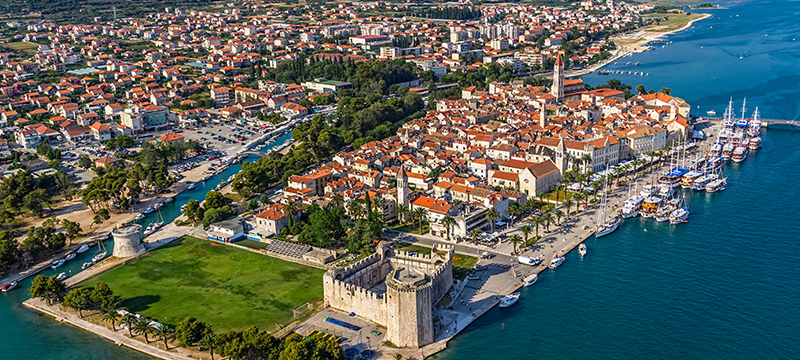
Just like the phrase “It’s always the right time for love”, we can candidly say “It’s always the right time for Trogir”, because this small Dalmatian town, whose town centre is steeped in history, where every stone embedded in the walls and narrow alleys tells its own story from the time of the Greeks, Romans and Venetians, delights all the senses. Hotel Restaurant Pašike, situated in the Buble family home, represents an unforgettable element of this ambiance. The family’s tradition in Trogir spans over lengthy eight centuries and tells the story of a rich family history that adds to the hotel’s charm, due to which it has been named Heritage. To our guests, we hereby recommend 10 cultural heritage sights they must visit during their stay in Trogir.
1. Kamerlengo Fortress
The Kamerlengo fortress or castle is located on the southwestern edge of the town of Trogir, in the corner of the town walls. Its oldest part is the polygonal tower dating back to the late 14th century. It also contains a chapel dedicated to St. Mark. The castle was built in the 15th century, from 1420 to 1437, and had served as housing facilities for the Venetian military troops. Today, Kamerlengo serves as a stage and a backdrop for numerous theatrical performances and other open-air cultural events.
2. Ćipiko Palace
The palace of the Trogir family Ćipiko is a complex made up of several buildings representing a combination of Romanesque, Gothic and Renaissance architectural styles, connected into a singular unit over time. The largest part of the complex was built in the 13th century. The southern gates of the palace carry the inscription “Nosce te ipsum”, which translates to “Know Thyself”. The palace itself contains numerous and valuable works of art, with the Gothic triforium carved on the façade, being the most prominent one among them.
3. Town gate
The south town gate, or porta civitatis, was built in 1953 in the Renaissance style. On its eastern side, there is a loggia, which served as an accommodation for travellers of the time, who would arrive to the town when the gate was already closed. Today it features a gallery and a souvenir shop. The north town gate, or porta terraefermae, adorned with a Venetian lion, was built in the 17th century and it connected the city to the mainland via a stone bridge. On the top of the gate, there is a statue of St John of Trogir, the patron saint of the town of Trogir.
4. Duke’s Palace
The Duke’s Palace dates back to the 13th century and it was restored in the Renaissance style during the 19th century. It contains historical coats of arms of Venetian dukes and other noblemen, and the door above the staircase contains an inscription stating that only noblemen are allowed access. The palace also had a theatre that had later been destroyed. Today, the building is host to the town’s administration – the Town Hall.
5. Trogir waterfront
Trogir waterfront is situated in the southern part of the town and was last restored in 2002. This first-rate promenade along the seafront, containing numerous hospitality facilities, is also the mooring location for yachts and mega yachts.
6. The Cathedral of St. Lawrence
The Cathedral of St. Lawrence is one of the most beautiful cathedrals in Croatia. Its construction went on for almost 300 years, and it was completed in its final form in 1598. It is widely known for Radovan’s portal, a work of unique artistic value, built in 1340, adorned with lions, apostles, saints, statues of Adam and Eve, and other ornaments. It has a 47-meter high bell-tower, with the interior of the cathedral representing a mix of Gothic, Renaissance and Baroque styles.
7. Benedictine Monastery of St. Nicholas
The Benedictine Monastery with a small church of St. Nicholas dates back to the 11th century, with the small church originally bearing the name of Saint Domnius. The monastery contains the oldest painting of the Mother of God with Child and a stone relief of Kairos, the Ancient Greek god of the favourable moment, dating back to the 3rd or 4th century BC. The legend says that he brings happiness to the person who grabs him by his lock of hair in an opportune moment.
8. Town Museum
Trogir Town Museum is located in the 18th-century Garagnin-Fonfogna Palace. The permanent museum exhibition bears silent witness to the city’s opulent history, containing a library of Trogir families.
9. Museum of Sacred Art
The Museum of Sacred Art is located on the site of an 18th-century rectory Romanesque palace and features a collection of early Venetian sacral painting, whereas the pinacotheca, along with other works by local artisans, contains the opus of Blaž Jurjev Trogiranin and a 13th-century polyptych, as well as numerous icons, crucifixes and sacral furniture pieces.
10. Love Tree
In Trogir, “always being the right time for love” is attested by an unusual tree that the residents of Trogir dubbed the Love Tree because of the discreet place where couples would gather, in the shade of a treetop. According to the romantic legend, a couple exchanging kisses in this place will carry eternal love in their hearts, until the day they perish.
Visit Trogir and let eternal love be the most beautiful souvenir you take home with you!